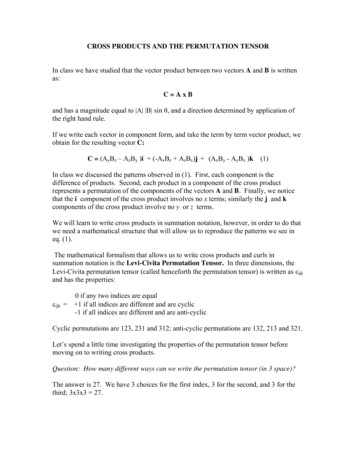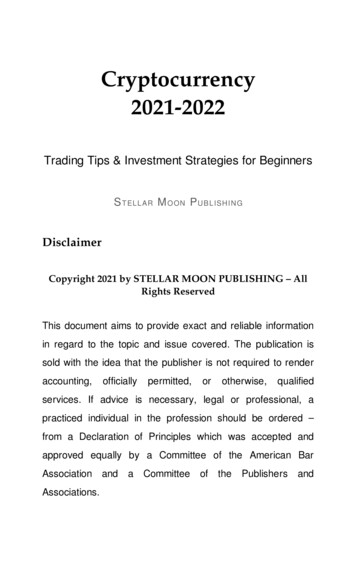
Transcription
CROSS PRODUCTS AND THE PERMUTATION TENSORIn class we have studied that the vector product between two vectors A and B is writtenas:C AxBand has a magnitude equal to A B sin θ, and a direction determined by application ofthe right hand rule.If we write each vector in component form, and take the term by term vector product, weobtain for the resulting vector C:C (AyBz – AzBy )i (-AxBz AzBx)j (AxBy - AyBx )kBBBBBB(1)In class we discussed the patterns observed in (1). First, each component is thedifference of products. Second, each product in a component of the cross productrepresents a permutation of the components of the vectors A and B. Finally, we noticethat the i component of the cross product involves no x terms; similarly the j and kcomponents of the cross product involve no y or z terms.We will learn to write cross products in summation notation, however, in order to do thatwe need a mathematical structure that will allow us to reproduce the patterns we see ineq. (1).The mathematical formalism that allows us to write cross products and curls insummation notation is the Levi-Civita Permutation Tensor. In three dimensions, theLevi-Civita permutation tensor (called henceforth the permutation tensor) is written as εijkand has the properties:εijk0 if any two indices are equal 1 if all indices are different and are cyclic-1 if all indices are different and are anti-cyclicCyclic permutations are 123, 231 and 312; anti-cyclic permutations are 132, 213 and 321.Let’s spend a little time investigating the properties of the permutation tensor beforemoving on to writing cross products.Question: How many different ways can we write the permutation tensor (in 3 space)?The answer is 27. We have 3 choices for the first index, 3 for the second, and 3 for thethird; 3x3x3 27.
What are these 27 different ways of writing εijk? It gets a little tedious, but it isinstructive to write out all these permutations:The twenty-seven possible permutations �312ε313ε321ε322ε323ε331ε332ε333We can use the definition of the permutation tensor given above to realize that only six ofthese terms are non-zero. These are ε123, ε132, ε213, ε231, ε312 and ε321. You should be ableto determine which of these equal 1 or -1.Let’s look at equation (1) in a little more detail to see how we can write cross products insummation notation. In this write-up we will denote x, y, z components by the indices 1,2, 3 respectively.As eq. (1) shows, the i component of C can be written as A2B3 – A3B2; the j componentcan be written as A3B1 – A1B3; and the k component as A1B2 – A2B1. The completevector C is of course the sum of all these components.BBBBBBLet’s consider now the expression:εijk AjBkB(2)First, notice that there are two repeated indices, j and k; this means that we will have tosum over j and k. The i index is not repeated and so is not summed over in thisexpression. Of course, i can be any integer between 1-3.Let’s write explicitly the sum represented by (2). Remember that we will sum over j andk; i is a dummy index that will run from 1 to 3. Remember also though that once wechoose a value of i, the values of j and k must be chosen so that no indices are the same(or else the the value of that particular term will be zero). Thus, we can write out theexpression in (2) explicitly:ε123 A2B3 ε132 A3B2 ε231 A3B1 ε213 A1B3 ε312 A1B2 ε321 A2B1 (3)BBBBBB
Make sure you review the expression in (3) carefully. Notice that these terms contain theonly non-zero terms of the permutation tensor. This pattern of components in (3) shouldlook very familiar by now.Using the properties of the permutation tensor described above, we can rewrite andrearrange(3) as:(A2B3 - A3B2) (A3B1 - A1B3) (A1B2 - A2B1)BBBBBBNotice that each parenthesis consists of one of the components of the cross product vectorC from eq. (1). Notice further that the terms in the first parenthesis correspond to i 1;the terms in the second parenthesis correspond to i 2; and the final parenthesiscorresponds to i 3.Thus, we can express the cross product C A x B in summation notation as:Ci εijk AjBk(4)BIn other words, the ith component of the vector C is given by the expression above, andthe complete vector C results from summing all its components.A simple proof:Let’s use this description of the cross product to prove a simple vector result, and also toget practice in the use of summation notation in deriving and proving vector identities.We know that the cross product of two vectors is perpendicular to each of the vectors;that is, we expect C Α and also C B. In terms of vector multiplication, this meansthat A·C 0 B·C. But we already know that in summation notation, the dot productbetween two vectors can be written as AiCi, since in summation notation you sum overrepeated indices, and the product AiCi A1C1 A2C2 A3C3 A·C.So, if we wish to prove that A·C 0 if C AxB using only summation notation, let’sbegin with the expression in (4) and realize that:AiCi Ai (εijk AjBk)B(5)Since we are now working only with scalar quantities, we can reorder the multiplicationson the right hand side any way we wish, and we can rewrite (5) as:AiCi Bk (εijk AiAj)(6)Examine the term in parentheses in (6). This term is simply the cross product of AxA.However, since the cross product of any vector with itself is zero (since the magnitude isproportional to sinθ), the expression AiCi is zero, and we have proven that the crossproduct is perpendicular to each of the original vectors.
USE OF SUMMATION NOTATION TO PROVE VECTOR IDENTITIESTHE “BAC-CAB” RULELet us consider the triple vector product:G A x (B x C)(1)You can write the cross products out term by term, but this becomes lengthy and messy.Using summation notation provides an elegant, terse and quick means of proving theseidentities.Here, we will show that:G A x (B x C) B(A·C) – C(A· B) (2)the so-called “BAC-CAB” rule.First, we set D B x C, and we can write the ith component of D as:Di ε ijk Bj Ck(3)BThen, we can write G A x D. We can write this cross product in summation notationas:Gm ε mni An Di(4)It is important to understand why these subscripts are chosen as they are in eq. (4). Wecannot use the same set of subscripts “ijk” again in the permutation tensor in (4); thesesubscripts were used in (3). While the exact choice of subscript is often arbitrary, weshould use a different set of subscripts in writing the new cross product.Notice, however, that we do use the subscript “i” for the D term. This is because D is thecross product of B and C, and we must use (3) as the expression for D in equation (4).Notice also the pattern of subscripts in (3) and (4). The first subscript in each Levi-Civitatensor refers to a component of the vector resulting from the cross product; in otherwords, the “i” in (3) means we are computing the “ith” component of D; the “m” in (4)means we are computing the “mth” component of G. The second subscript refers to acomponent of the first vector in the cross product, and the final subscript labels acomponent of the second vector in the cross product.We can now substitute the expression for Di from (3) into (4) and obtain:Gm ε mni An (ε ijk Bj Ck)B(5)
Since all the terms in (5) are scalars, we can rearrange terms and write:Gm ε mni ε ijk An Bj Ck(6)BWe realize that ε mni ε nim ε imn , so we can rewrite (6) as:Gm ε imn ε ijk An Bj Ck(7)BRecognize that in (7) we have a product of two permutation tensors, and each has thesame index (“i”) in the same location. This allows us to use the “ε δ” relationship:ε imn ε ijk δjm δkn - δkmδjn(8)Using the relationship in (8) to expand the product of permutation tensors in (7) yields:Gm (δjm δkn - δkmδjn) An Bj CkB δjm δkn An Bj Ck - δkmδjn An Bj Ck (9)BBLet’s consider each term on the RHS of (9). In order that the first term be non-zero, wehave the conditions that j m and k n. The second term can be non-zero if and only ifk m and j n. Making these substations in (9) gives:Gm An Bm Cn - An Bn CmB(10)BSince we are dealing with scalar quantities, we can switch order of multiplication as weplease, allowing us to write (10) in the very recognizable form:Gm Bm (An Cn) - Cm (An Bn)B(11)Note that the terms in parentheses are A·C and A·B. So we can readily observe that (11)is the component form of the vector identity:G B (A·C) – C(A·B)QED(12)
TRIPLE VECTOR PRODUCTProof of x ( x F) ( · Α) 2FThe proof of this identity follows the same path of the proof of the “BAC-CAB” identity.First, we set A x F, so that G x A. We can the write the “ith” component of Aas:Ai εijk ( / xj F k)(1)and G x A becomes:Gm εmni ( / xn Ai) εmni / xn (εijk / xj Fk) εmni εijk / xn ( / xj Fk )(2)As before, we can permute the first Levi-Civita symbol so that (2) becomes:εimn εijk / xn ( / xj Fk )(3)We can now apply the “ε – δ” relationship to (3) to obtain:Gm (δjmδkn – δjnδkm) ( / xn ( / xj Fk ))(4)Equation (4) admits two terms; in the first term on the RHS of (4), we see that:j mk nIn the second term on the RHS:j nk mMaking these substitutions into (4) we get:Gm / xn ( / xm Fn ) - / xn ( / xn Fm) (5)We are almost done, believe it or not. We just have to recognize what these terms in (5)represent. Let’s look at the first term in the RHS of (5). We can rearrange the order ofdifferentiation (always valid for continuously differentiable functions) and obtain:
/ xm ( / xn Fn )(6)However, it should be apparent that the term in parentheses, ( / xn Fn) is merely · F, and / xm of · F is the “mth” component of the gradient of the scalar function · F.We can write the second term on the RHS of (5) as ( / xn / xn )Fm . This is just the“mth” component of 2F, and putting all this together yields the desired identity: x ( x F) ( · F) 2F
Levi-Civita permutation tensor (called henceforth the permutation tensor) is written as . cross product of B and C, and we must use (3) as the expression for D in equation (4). Notice also the pattern of subscripts in (3) and (4). The first subscript in each Levi-Civita tensor refers to a component of the vector resulting from the cross product; in other words, the “i” in (3) means we .File Size: 223KBPage Count: 7











